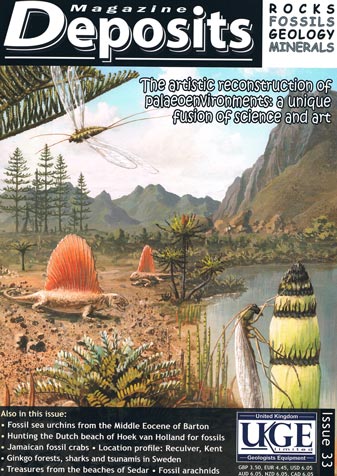Deposits Magazine (Issue 33) Reviewed
The spring edition of the magazine for geologists, mineralists and fossil fans has duly arrived and this UK produced magazine certainly packs a punch with issue 33. The front cover shows an artist’s interpretation of the palaeoenvironment of Russia during the Late Permian. This is an example of the artwork of Lyme Regis based illustrator Richard Bizley and inside there is a highly informative article all about Richard’s work re-creating prehistoric and alien landscapes.
Richard likes to focus on some of the unsung heroes from the fossil record. His landscapes feature a whole range of prehistoric animals and plants, the fauna and flora depicted all painstakingly researched to ensure accuracy. The artwork is truly stunning and the detail simply exquisite.
The Front Cover of Deposits Magazine (Spring 2013)
Picture credit: Everything Dinosaur
Deposits Magazine
Visitors to Holland can perhaps be inspired about an article about hunting for Ice Age fossils on the Dutch beach of Hoek van Holland. It seems that land reclamation and construction work to prepare sea defences leads to a lot of material being dredged up from the bottom of the North Sea – amongst the sand there are many fossils of prehistoric mammals that get deposited on the beaches of this low-lying country.
Fossil hunters can find teeth of Woolly Mammoths, bones from Woolly Rhinos (Coelodonta) and even Mesolithic spear tips and fishing harpoons. Further afield, there are very well illustrated articles on fossil hunting for Mesozoic aged fossils including beautiful Ginkgo fossils in southern Sweden and a fascinating article on Jamaican fossil crabs. Decapod crustaceans (crabs) have got their own army of dedicated fossil collectors who specialise in collecting specimens of these arthropods. The article outlines the types of fossil crabs that can be found on the Caribbean island of Jamaica. The handy glossary of terms presented at the end of the article helps the uninitiated to gain an insight into just how fascinating collecting fossils of crabs can be.
Arachnid Article
Arachnids, the likes of spiders, mites, scorpions and their near relatives have a large article dedicated solely to them in this issue of Deposits magazine. This feature jointly written by Dr David Penney (University of Manchester) and Dr Jason Dunlop, the curator of myriapods and arachnids at the Berlin Natural History Museum is extremely comprehensive and packed with beautiful photographs and computer enhanced images. As artist Richard Bizley loves to incorporate Arachnids into his artwork it makes perfect sense to include a detailed review of the Arachnid fossil record in the same issue as a feature on the artistic reconstruction of palaeoenvironments – a unique fusion of science and art.
The magazine provides book reviews, including a couple on the volumes published to help walkers explore the Jurassic coast of southern England, lots of news stories and there is even a feature on fossil amber found in Scotland. For those prepared to get out and about this spring there are articles on hunting for Middle Eocene sea urchins and a detailed review of the fossils to be found on a visit to Herne Bay in Kent.
Update on Recent Fossil Discoveries
For readers who live in Colorado (United States of America), there is an update on some of the rare, recent fossil discoveries from the famous Morrison Formation of western North America. A rare fossil of a gastropod (snail) has been discovered, it has been turned to agate over millions of years (shell replaced by the mineral agate). Dinosaur fossils may make the headlines but this snail fossil provides scientists with valuable evidence to help reconstruct life in freshwater habitats during the Late Jurassic.
All in all, this is an excellent magazine that covers a whole range of subject areas of interest to palaeontologists, geologists, mineralists and fossil fans. The articles are written in a way that allows the layperson to follow what is being said with scientific terms reduced to a minimum. Issue 33 of Deposits magazine is well worth reading.
Visit Everything Dinosaur’s award-winning website: Everything Dinosaur.



Leave A Comment